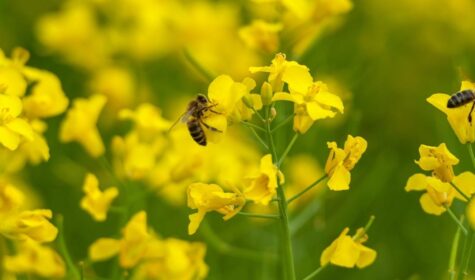Loopholes
The UK is not alone in bending the rules to allow neonicotinoids to be used, despite the ban. As Greenpeace exposed and the Farmers Guardian points out, over the last three years, many EU countries have granted exemptions permitting the use of neonicotinoids. Farmers Guardian refers to 12 EU countries that have allowed their use. Greenpeace found evidence of at least 67 ‘emergency’ authorisations, one for use on a golf course.
To be fair to Defra, the UK appears to have taken a more cautious approach than some EU countries. It has agreed a limited derogation for sugar beet only, based on a predicted high level (68.9%) incidence of virus yellows, a disease spread by aphids. Last year the incidence was predicted at only 8%, so the derogation was held back. In 2020, when neonicotinoids were not permitted, 38% of plants were infected and some growers lost 80% of their crop. Defra has also included additional restrictions. In a tacit recognition that neonicotinoids persist in soil, no flowering crops can be grown on the same field as treated sugar beet for 22 months or oilseed rape for 32 months.
Yet, despite our prudence at home, further Greenpeace research found that the UK and the EU are nevertheless still manufacturing and exporting thousands of tonnes of neonicotinoid insecticides and exporting them around the world, including to Ukraine where they are used on oilseed rape which we then import.
Continuing use of other pesticides on oilseed rape in the UK
The UK ban on neonicotinoids does not mean insecticides are no longer used on oilseed rape. After the ban, most growers switched to the synthetic pyrethroids. These are broad spectrum insecticides, meaning they kill most insects, but they are much less persistent in the environment than the neonicotinoids. If they are allowed to contaminate watercourses or streams, however, even tiny amounts can wipe out aquatic species. Because the synthetic pyrethroids are less effective than neonicotinoids at controlling insect pests, farmers also need to spray repeatedly. This is likely to be one of the factors behind emerging synthetic pyrethroid resistance in pollen beetles and why farmers are now advised by the AHDB only to spray if they cannot control pests any other way. Yet, rape isn’t only sprayed with insecticides, it is also treated with a range of herbicides and fungicides. In addition, it receives high applications of nitrogen fertiliser (with leakage to the environment generally higher than from many other crops) where this has a number of damaging impacts. The controversial herbicide, glyphosate, sold as Roundup and under other brand names, is also now usually sprayed to kill the crop before harvest instead of using the traditional method of cutting and leaving the swaths to dry first.
Oil seed rape – changes made by UK growers since the ban
UK oilseed rape growers have been forced by the ban to make changes to their practices, with varying impacts on sustainability. The development of new varieties with greater resistance to some diseases is helping. Growing rape less often in the rotation and using cover crops to confuse the pests are two options that clearly improve sustainability. The other major change, the move to earlier sowing of the crop, straight after barley in July or wheat in August, has less clear sustainability benefits. This is because there is a biodiversity downside. In theory, early establishment of rape should reduce carbon losses from arable soils and possibly even reverse them sometimes, but the rapid transition of almost all stubble fields to a following crop, these days, has impacts on wildlife. As the RSPB explains, cereal stubbles were traditionally rich feeding grounds where birds and hares could build up their reserves before the winter.
Early drilling has two advantages for farmers. It means the plants will often be strong enough to survive attacks from the most serious autumn pest, cabbage stem flea beetle, even if somewhat damaged. If the damage is too serious, there is then still time to kill the rape off with yet more glyphosate and sow a different crop. With some companies offering to give farmers replacement seeds free of charge when this happens, the area of rape grown in the UK increased last year to 492,000 hectares from a low point of 345,000 hectares in 2020, but still well down on the 760,000 hectares planted in 2012.
As a result, UK rape imports rose from 57,000 tonnes in 2015/16 to over 630,000 tonnes last year, largely due to the ban. In a sign of the growing difference between the standards required of farmers in the UK and those required of producers from whom we import food, a significant proportion of the imported rape came from Ukraine, where neonicotinoids are still permitted.
Adding an historical perspective
When I was lucky enough to get the tenancy of my first farm on the Cotswolds, in 1969, some of my neighbouring farmers were still including grass and clover in their crop rotations. This would be grazed by cattle or sheep and a hay crop was also taken. At the time no rape was being grown on the Cotswolds (and probably not anywhere in the country), while the introduction of Roundup in the UK was still seven years away.
The first rape varieties grown in the 1970s were very low yielding, typically producing less than a tonne per hectare. But with the price of wheat and other arable crops rapidly increasing at the time and the continuous growing of combinable crops becoming much more profitable than mixed farming, rape provided a lucrative arable break crop for grain farmers, and grass disappeared from virtually all rotations, except those of organic farmers. Today, yields from modern varieties are three or four times as high as back then.
Dietary fats and oils
On average, fats and oils provide 35% of our daily energy requirement in the UK. Fats (including fish oils) are also the major source of essential fatty acids and a range of vitamins. During the 20th century, there was a progressive shift away from animal fats towards vegetable oils. This was driven by concerns about the health impacts of saturated fat (whether these were justified is an issue for another day). Farmers were heavily penalised for sending animals to slaughter with more than minimal amounts of body fat, and traditional breeds of cattle and pigs went into a steep decline. Initially, from the 1930s, vegetable oil consumption was mostly in the form of soyabean oil, which was hydrogenated to make it hard enough for margarines and processed foods, resulting in the creation of trans fats, now recognised as the very worst type of fats for our health. Other questions about the health impact of so much vegetable oil in our diet remain. The amount of omega-6 we consume compared with omega-3 has increased dramatically. A few scientists link this to poor brain health, including dementia (the brain being mostly made of fat), to cancer and to other diseases, but others still argue the overall impact has been beneficial.
Food security
Vegetable oils produce a great deal more fat per hectare than grazing animals. From this perspective, the widespread growing of oilseeds has been one of the changes that helped to make possible the global population increase from 4 billion in 1975 to almost 8 billion today. Without it there would not be enough fat to go round. Of course, the growing of palm oil on former rainforest has come at an even greater cost, with its tragic consequences for indigenous wildlife as well as global warming. The huge increase in oilseed production worldwide has, additionally, helped enable the intensification of livestock production – a major cause of environmental damage, but a trend that also poses problems for food security. This is because intensive livestock systems consume a vast amount of arable crop byproducts, left once oil or sugar has been extracted, including soyabean meal, rapeseed cake and sugar beet pulp, grown on land that from a human nutritional perspective, would be more efficiently used to produce crops for direct consumption.
Conclusion
As someone who has finally managed to eliminate virtually all sugar from my diet, something I long believed I would never be able to do, I’m tempted to conclude, in relation to the use of neonicotinoids in sugar beet production, that we really need to revaluate society’s addiction to sugar, which we consume in industrial quantities, at the expense of our own health and the expense of our soils.
As for rape oil, the solutions are less simple. It is possible to grow rape organically but not on a huge scale and the best yields have been in Scotland and Sweden, where colder winters reduce the burden of pests and diseases. Global warming is likely to increase the challenges faced by growers still further. Hedgerow removal, increased field size and decades of chemical onslaught on the countryside have decimated natural predators, increasing reliance on pesticides. However, with resistance to herbicides increasing in arable weeds and to insecticides in pests, the long-term technical sustainability of rape production on the current scale must be in doubt anyway.
Essentially, we need to grow less rape if it is to be done sustainably. Reducing the amount that is used for biofuel would help, but rather than importing more to make up the shortfall in the UK, we should also look at other ways we can produce dietary fats domestically. There may be scope to grow a wider range of oilseed crops in a more sustainable fashion, but we should also consider reintroducing animal fats into our diets and changing the fat-grading systems to make more animal fats available. At the very least there is a case for using beef fat from grass-fed cattle as a cooking oil instead of rape oil, or chip fats containing palm oil, which is 50% saturated fat, just the same as beef fat. We could also increase the availability of lard from free range pigs to replace vegetable shortening, by changing breeds and letting them live longer.
Ultimately, decisions around where we source our dietary fats, and how they are grown, are just one part of an incredibly complex puzzle. If the UK is unable to source rape from Ukraine this year due to the war, we will probably be just one of many countries hoping the US can supply us. But neonicotinoids are also still in very widespread use there. If we don’t want to see yet more rainforest destroyed for palm oil and more virgin grasslands go under the plough to produce more soya and rape, societies at a global level (but particularly in the developed world) will need to shift to much more sustainable patterns of consumption. In my personal opinion, we also need to redouble our efforts to limit population growth and ideally, if want the planet to remain habitable for future generations, we need to create a culture where everyone comes to realise that a steady global population decline would be in all our best interests.



